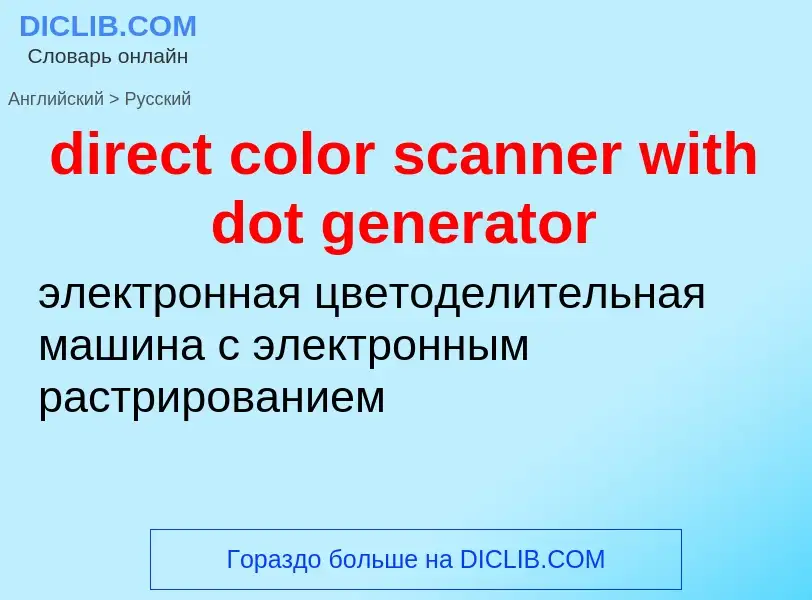Перевод и анализ слов искусственным интеллектом ChatGPT
На этой странице Вы можете получить подробный анализ слова или словосочетания, произведенный с помощью лучшей на сегодняшний день технологии искусственного интеллекта:
- как употребляется слово
- частота употребления
- используется оно чаще в устной или письменной речи
- варианты перевода слова
- примеры употребления (несколько фраз с переводом)
- этимология
direct color scanner with dot generator - перевод на русский
color="gray">общая лексика
блок питания
механизм исполнительный
color="gray">строительное дело
силовая установка, силовое оборудование
силовой блок
color="gray">строительное дело
турбогенератор
color="gray">общая лексика
генератор постоянного тока
Определение
Википедия

The coastal zone color scanner (CZCS) was a multi-channel scanning radiometer aboard the Nimbus 7 satellite, predominately designed for water remote sensing. Nimbus 7 was launched 24 October 1978, and CZCS became operational on 2 November 1978. It was only designed to operate for one year (as a proof-of-concept), but in fact remained in service until 22 June 1986. Its operation on board the Nimbus 7 was limited to alternate days as it shared its power with the passive microwave scanning multichannel microwave radiometer.
CZCS measured reflected solar energy in six channels, at a resolution of 800 meters. These measurements were used to map chlorophyll concentration in water, sediment distribution, salinity, and the temperature of coastal waters and ocean currents. CZCS lay the foundations for subsequent satellite ocean color sensors, and formed a cornerstone for international efforts to understand the ocean's role in the carbon cycle.



![The [[Faraday disk]] was the first electric generator. The horseshoe-shaped magnet ''(A)'' created a magnetic field through the disk ''(D)''. When the disk was turned, this induced an electric current radially outward from the center toward the rim. The current flowed out through the sliding spring contact ''m'', through the external circuit, and back into the center of the disk through the axle. The [[Faraday disk]] was the first electric generator. The horseshoe-shaped magnet ''(A)'' created a magnetic field through the disk ''(D)''. When the disk was turned, this induced an electric current radially outward from the center toward the rim. The current flowed out through the sliding spring contact ''m'', through the external circuit, and back into the center of the disk through the axle.](https://commons.wikimedia.org/wiki/Special:FilePath/Faraday disk generator.jpg?width=200)
![alternating current generator]], c. 1900. alternating current generator]], c. 1900.](https://commons.wikimedia.org/wiki/Special:FilePath/Ferranti two-phase generator set (Rankin Kennedy, Electrical Installations, Vol III, 1903).jpg?width=200)
![Early [[Ganz]] Generator in [[Zwevegem]], [[West Flanders]], [[Belgium]] Early [[Ganz]] Generator in [[Zwevegem]], [[West Flanders]], [[Belgium]]](https://commons.wikimedia.org/wiki/Special:FilePath/Generator-20071117.jpg?width=200)
![commutator]] needed for high power applications. commutator]] needed for high power applications.](https://commons.wikimedia.org/wiki/Special:FilePath/High-Current Copper-Brush Commutated Dynamo.jpg?width=200)

![kVA]] direct-driven power station AC alternator, with a separate belt-driven exciter generator. kVA]] direct-driven power station AC alternator, with a separate belt-driven exciter generator.](https://commons.wikimedia.org/wiki/Special:FilePath/Murray Alternator with Belt-Driven Exciter.jpg?width=200)
![[[Hippolyte Pixii]]'s dynamo. The commutator is located on the shaft below the spinning magnet. [[Hippolyte Pixii]]'s dynamo. The commutator is located on the shaft below the spinning magnet.](https://commons.wikimedia.org/wiki/Special:FilePath/Wechselstromerzeuger Crop LevelAdj.jpg?width=200)
